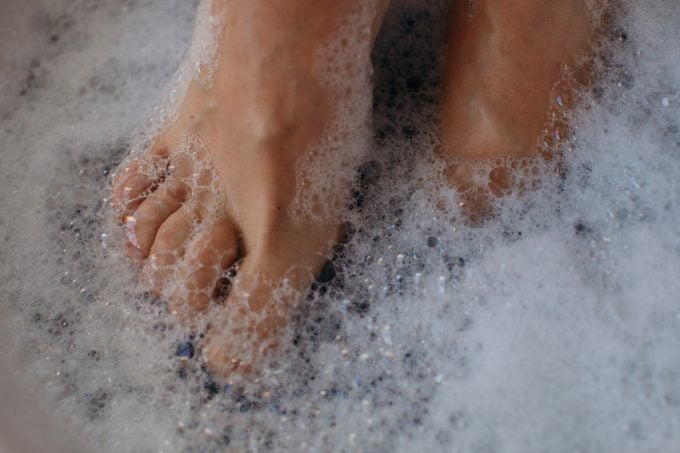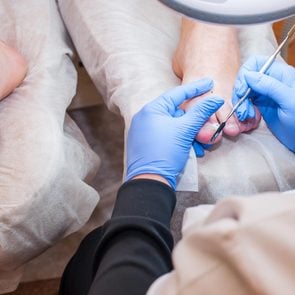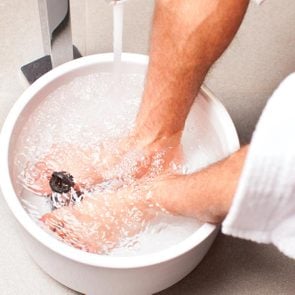How to Do a Foot Soak for Toenail Fungus, Plus 4 Products to Try
Updated: May 19, 2021
A warm foot soak may help soothe toenail fungus symptoms. Here's how to make a soak with vinegar or baking soda, what to expect, and over-the-counter foot soak options (like tea tree oil) to try at home.
Our editors and experts handpick every product we feature. We may earn a commission from your purchases.
What is toenail fungus?
Most of us don’t think of toenail fungus on a day-to-day basis. But the day you notice you’re sporting yellow toenails or white toenails? Fungus will stay top of mind.
Those discolored and thickened toenails often point to onychomycosis, a toenail fungus infection. Fungi make up 50 percent of all nail problems, and fungus occurs on the toenails four to 10 times more frequently than it does on the fingernails.
Luckily, toenail fungus doesn’t turn into a major health crisis, but it can be very unpleasant.
“Nail fungus is hard to live with. Some patients experience pain or difficulty doing everyday activities and fitting shoes,” says dermatologist Shari Lipner, MD, an associate professor of clinical dermatology at Weill Cornell Medicine in New York. “There is also a stigma surrounding nail fungus, so many people are embarrassed that they have this.”
Here’s what you should know about toenail fungus, how foot soaks can help, and what home remedies and over-the-counter (OTC) products to try.
What toenail fungus infections do to your toenails
It’s common to have fungus living harmlessly on your skin, but sometimes it can multiply and lead to a toenail infection. The fungus can easily spread when it invades the skin beside or under the toenail.
When it comes to the types of toenail fungus, distal subungual onychomycosis is the most common subtype of onychomycosis, Dr. Lipner says.
In this condition, the fungus enters the nail bed underneath the nail, primarily affecting the big toe. The infection causes the toenails to thicken, and a yellowish-white to yellowish-brown discoloration occurs in the center of the toenail. There may be pain and mild inflammation.
Often the nail chips and becomes jagged, eventually separating from the nail bed. People with the highly contagious athlete’s foot are more prone to getting distal subungual onychomycosis.
“It is very common for family members to get it from other household contacts,” says Dr. Lipner.
Another subtype, called white superficial onychomycosis, is less common than distal. Unlike other forms of onychomycosis that affect toenails and fingernails, white superficial only affects the toenails.
“In white superficial onychomycosis, the infection is on the top layers of the hard part of the nail, not deep under the nail. So it is generally easier to treat,” says Dr. Lipner.
Symptoms of this type include small, white, powdery-looking patches that appear randomly on the toenail. The nail becomes soft and crumbles easily.
How to treat toenail fungus
Toenail fungal infections, no matter the type, rarely go away without prescription medical treatment. over-the-counter (OTC) products might help soothe symptoms, but they don’t kill the fungus. That usually takes several months or up to a year to fully cure.
Generally, oral and topical antifungal medications are prescribed.
“The slowness of the treatment is due to the slow growth of the nails. Toenails grow on average only 1 millimeter per month, so it takes one year for the whole nail to grow out,” says Dr. Lipner.
In addition to prescription medicine therapy, there are a few toenail foot soaks you can try to soothe symptoms and promote healing.

What to expect from a toenail fungus soak
While some toenail fungus infections are easier to treat than others, we should be clear that you shouldn’t solely rely on a toenail fungus soak to kill fungus permanently.
“I haven’t seen any compelling evidence that soaks will help in the treatment of fungal infection of the nails,” says dermatologist Rajani Katta, MD, who serves as volunteer clinical faculty at Baylor College of Medicine and McGovern Medical School at UT Health in Houston.
However, a soak may help ease symptoms such as itching and burning and help stave off bacteria. It could take weeks or several months of consistent soaks to see improvement—or they might not work at all.
Be mindful that although your toes look and feel better, the fungus could still be alive and lingering and can spread to other toes and areas of the foot.
One caveat: if you have diabetes and notice changes in your toenails or feet—think redness, swelling, a color change, or a black vertical streak on your toenail—don’t try a foot soak. In fact, people with diabetes should check in with a doctor if they notice any foot-related changes at all.
Vinegar foot soak for toenail fungus
Vinegar is an old-timey remedy that people still swear by, citing beauty benefits and a purported ability to aid weight loss and skin concerns. And it can possibly aid toenail fungus.
Keep in mind that research on vinegar for fungus is pretty slim. More studies are needed before scientists can say for certain whether this home remedy actually works.
Still, doctors have witnessed good results with vinegar foot soaks. So it may be worth a shot.
Be sure you’re properly mixing up the foot soak. You can use white vinegar or apple cider vinegar.
“In our clinic, we use two parts warm water to one part white vinegar. We have the patients soak for 10 to 15 minutes a day,” says Joseph Zahn, MD, a dermatologist at the GW Medical Faculty Associates in Washington, D.C.
“Be sure to dry well between the toes and apply moisturizer,” says Cara Wylie, DPM, primary podiatric medicine specialist with UCHealth Foot and Ankle Center-Central in Denver, who has seen positive outcomes when her patients soak three times a week for a year.
“It takes nine months to a year for the nails to grow out, so this is why you have to do this for so long a period. There are other soaks, but I find this to be safest and best,” says Dr. Wylie.
Vinegar soak for bacteria
“Patients with onychomycosis may sometimes develop a bacterial infection at the same time, which leads to a greenish discoloration of the nail,” says Dr. Katta. “This discoloration is usually caused by a particular bacteria called pseudomonas. For this type of infection, vinegar soaks may be helpful.”
In short, vinegar could help reduce (but may not completely clear orcure) both fungus and bacteria infections.
Vinegar contains acetic acid, which can help battle the bacteria that causes the greenish discoloration.
To get the most from this soak, follow these instructions:
- Combine one part white vinegar with four parts lukewarm water.
- Soak for five minutes twice a day.
- Rinse after soaking and dry the skin completely.
A word of caution: don’t put your feet in this soak if you have cracks in your skin, Dr. Katta says.
Baking soda foot soak
Where would we be without this inexpensive pantry wonder? Baking soda can banish blackheads, soothe itchy and sunburned skin, and may curb fungus growth. (And that’s not even touching on its culinary and cleaning uses.)
According to a study in Mycopathologia, lab tests revealed baking soda is effective at suppressing the growth of fungus.
Here’s how to prep your foot bath:
- Fill a basin with warm water.
- Add a half cup of baking soda.
- Soak for 15 to 20 minutes.
- Dry feet completely. (Don’t forget between the toes!)
Over-the-counter foot soaks
Vinegar and baking soda are inexpensive options, but if you want a ready-to-use treatment—no mixing required—you can try an over-the-counter product.
Before you buy, check the list of ingredients to make sure they’re antifungal and antibacterial—tea tree oil is the most common. (That said, the research on its effectiveness is minimal, and more studies are needed.) You might also find baking soda in an OTC foot soak, like Daily Remedy’s product below.
Many foot soak products for fungus include tea tree oil and Epsom salts because they help eliminate odors and treat other symptoms.
To take the guesswork out of finding a good foot soak, we’ve rounded up some products that are highly rated on Amazon:
- Daily Remedy Calming Lavender Foot Soak ($17)
- Purely Northwest Tea Tree Oil Foot and Nail Soak ($15)
- Earthborn Elements Tea Tree Epsom Salt ($30)
- M3 Naturals Tea Tree Oil Foot Soak ($20)
Caring for toenails when you have a toenail fungus
While you’re treating a toenail fungus infection, it’s imperative to keep your feet out of moist and warm environments, where fungus thrives.
Here are some other ways to care for your toenails and fend off the recurrence of fungus:
- Don’t walk barefoot in locker rooms or public showers, around swimming pool decks, or in other moist and warm environments.
- Wear shoes made of breathable materials.
- Wear absorbent socks and use antifungal foot powder.
- Keep toenails clean and dry—and don’t forget to dry between the toes.
- Toss old shoes or coat with antifungal spray or powder.
- Keep your toenails short.
- Give your toenails a break from the drying effects of nail polish.
When to see a doctor
If you have diabetes and notice any of the symptoms below, call your doctor for treatment.
If you have been attempting to treat toenail fungus at home and see your toenails are changing in appearance, call your doctor for diagnosis and treatment.
These are the signs you may have a full-blown toenail fungal infection:
- Growing discoloration of white, yellow, yellowish-brown, or blackish-green on the toenail
- Nails appear to be powdery, thick, brittle, or split
- Nail bed changes shape
- Mild or foul odor coming from the toenail
- Toenails become painful and red, or drain pus
- Any systemic symptoms such as fever, chills, weight loss, and night sweats
Next, learn 10 reasons you might have toe pain.






















